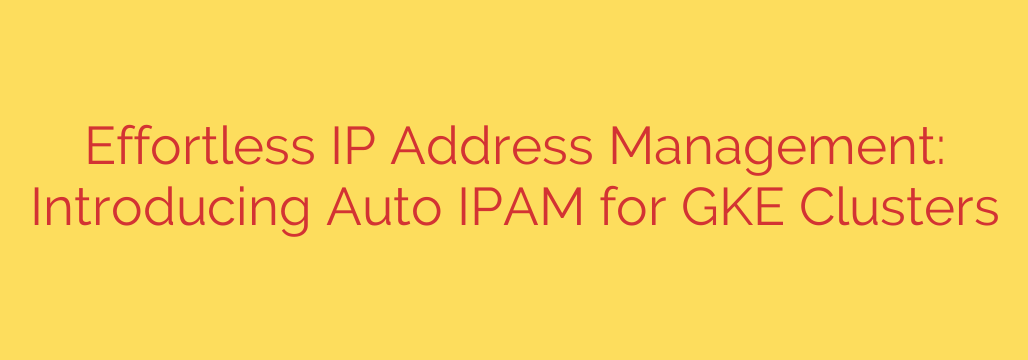
Automating GKE IP Address Management: A Deep Dive into Auto IPAM
Managing IP addresses in a large-scale Kubernetes environment is one of the most persistent operational challenges for platform engineering and DevOps teams. The process, often referred to as IP Address Management (IPAM), involves careful planning, tedious calculations, and the constant risk of human error. For those running Google Kubernetes Engine (GKE), this has traditionally meant manually defining CIDR ranges for pods and services, a task that becomes exponentially more complex as your organization scales.
Miscalculations can lead to critical issues, including IP address exhaustion, which can halt application deployment, or overlapping IP ranges, which can cause unpredictable network failures that are difficult to diagnose. These challenges represent a significant administrative burden, pulling valuable engineering time away from innovation and toward manual network configuration.
Fortunately, a more streamlined approach is now available, designed to transform this complex task into a fully automated, “set-it-and-forget-it” process.
The Core Challenge of Manual IPAM in Kubernetes
Before exploring the solution, it’s important to understand the specific pain points associated with manual IPAM in a GKE environment:
- Complex Pre-Planning: Administrators must meticulously plan and allocate blocks of IP addresses for each cluster’s pods, ensuring the range is large enough for future growth but not so large that it wastes valuable IP space.
- High Risk of Overlap: In an organization with dozens or hundreds of clusters, the risk of accidentally assigning overlapping CIDR ranges is incredibly high. This can lead to severe connectivity issues between clusters or with other resources in your Virtual Private Cloud (VPC).
- Operational Overhead: Maintaining spreadsheets or other manual tracking systems for IP allocation is inefficient and prone to error. It slows down the process of spinning up new clusters and adds a layer of unnecessary friction.
- Inefficient IP Utilization: When a cluster is decommissioned, its assigned IP range must be manually tracked and reclaimed for future use. Forgetting this step leads to orphaned IP blocks and wasted address space.
Introducing a Smarter Solution: Automated IP Address Management
To address these challenges directly, GKE now offers a powerful capability for automated IP address management (Auto IPAM). This feature offloads the responsibility of allocating pod IP address ranges from the user to the GKE control plane itself.
Instead of requiring you to specify a pod CIDR range during cluster creation, GKE intelligently and automatically selects an available range for you. This simple yet profound change fundamentally simplifies the process of launching and managing Kubernetes clusters.
How GKE Auto IPAM Works
The mechanics behind this automated system are designed for both simplicity and reliability. Here’s a breakdown of the process:
- Intelligent Range Selection: When you create a new GKE cluster without specifying a pod IP range, the GKE control plane automatically carves out an appropriately sized
/22range from the broader10.0.0.0/8IP address space. - Conflict Prevention: Crucially, GKE maintains awareness of all IP ranges allocated to other clusters within the same VPC. This ensures that the newly selected range is guaranteed to be unique, completely eliminating the risk of overlapping CIDR blocks.
- Automated Lifecycle Management: The automation extends beyond just allocation. When a GKE cluster is deleted, the control plane automatically disassociates the IP range, returning it to the pool of available addresses. This ensures efficient IP recycling without any manual intervention.
Key Benefits of Adopting Auto IPAM
Integrating this automated approach into your GKE workflow provides several immediate and long-term advantages:
- Reduced Operational Overhead: By removing the need for manual IP planning and tracking, platform teams can focus on higher-value tasks. The cognitive load of managing complex network layouts is significantly diminished.
- Enhanced Reliability and Stability: Automating IP allocation eliminates the primary cause of network conflicts—human error. This leads to a more stable and predictable networking environment for your applications.
- Effortless Scalability: Teams can now spin up new GKE clusters on demand without getting bogged down by IP address request forms or manual allocation processes. This accelerates development and deployment cycles.
- Simplified Cluster Creation: The process of creating a new cluster becomes faster and less error-prone. You simply define the cluster’s core specifications and let GKE handle the underlying network configuration.
Getting Started: How to Enable Auto IPAM
Using this feature is remarkably straightforward. It is available for new GKE clusters running version 1.29.3-gke.1093000 or later.
To enable Auto IPAM, you simply omit the --cluster-ipv4-cidr and --services-ipv4-cidr flags when creating a new cluster via the gcloud command-line tool. GKE will interpret the absence of these parameters as a request to manage the pod IP range automatically.
For example, a simplified cluster creation command would look like this:
gcloud container clusters create CLUSTER_NAME \
--zone COMPUTE_ZONE \
--release-channel regular
By not specifying the pod CIDR block, you are instructing GKE to take over its management. It’s important to note that this feature currently manages the primary pod IP address range.
The Future of Effortless Cloud Networking
Automated IP address management represents a significant leap forward in simplifying cloud-native operations. By abstracting away one of the most complex and error-prone aspects of Kubernetes networking, it allows organizations to build and scale their infrastructure with greater speed, confidence, and reliability. Adopting features like Auto IPAM is a critical step toward building a truly efficient, self-managing cloud environment.
Source: https://cloud.google.com/blog/products/containers-kubernetes/gke-auto-ipam-simplifies-ip-address-management/








